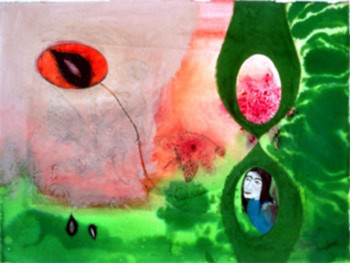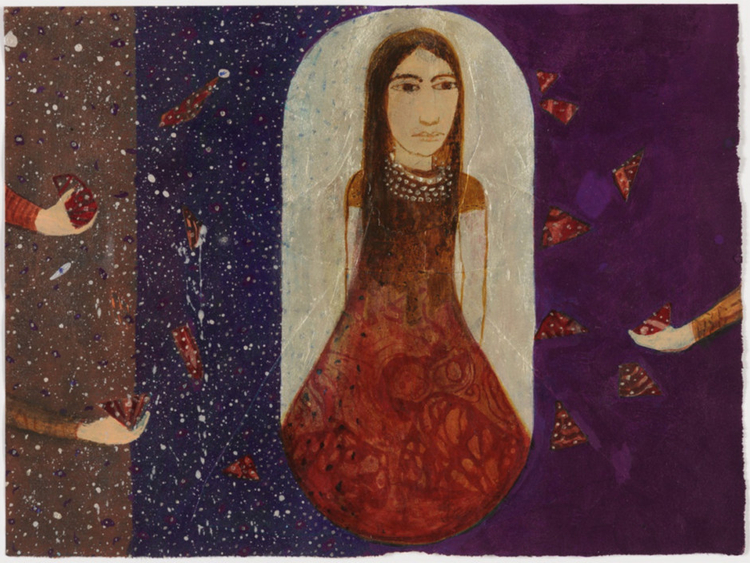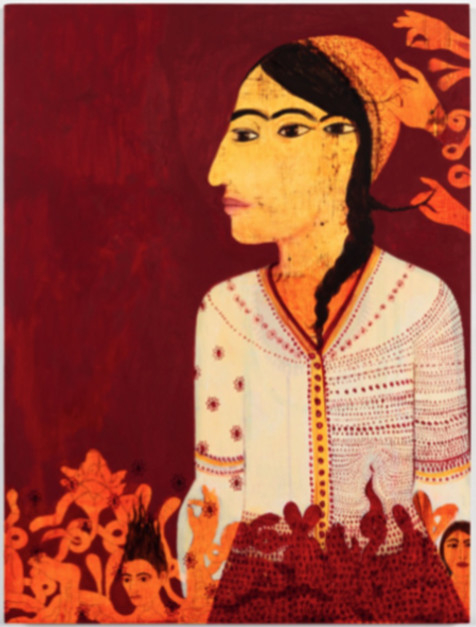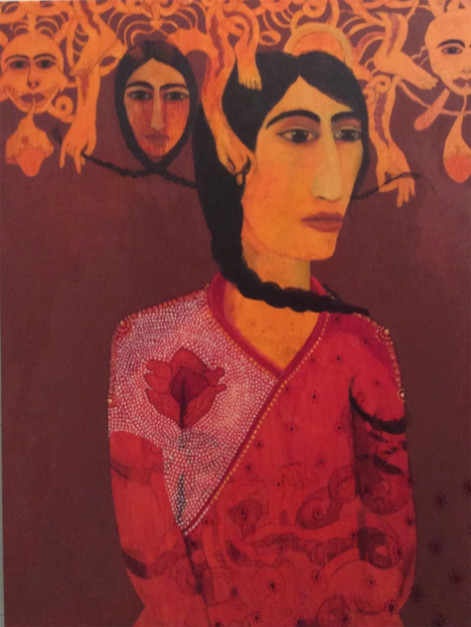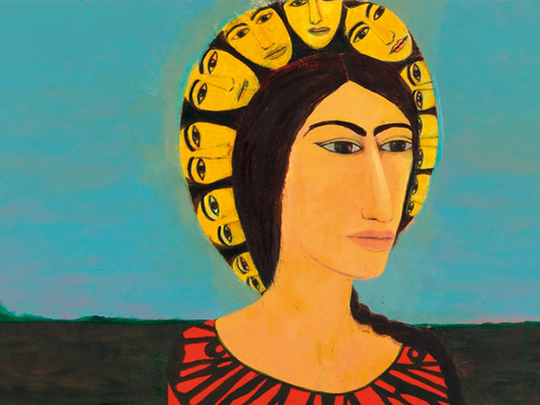
Samira Abbassy was born in Iran, grew up in London, and moved to New York after her marriage, where she founded the Elizabeth Foundation for the Arts Studio Program NY. Her recent work stems from the fact that despite never having lived in Iran, she is expected to know about the country and to justify it. In her second solo show in Dubai, Redemptive Narratives and Migrating Patterns, she is presenting ink and charcoal drawings on paper, and oil paintings on gesso panel, created between 2002 and 2016, that speak about her search for self, and her desire to go beyond self to become one with all of humanity.
In her paintings, the artist has combined references from Greek mythology, Medieval Christian iconography, symbols from Tibetan Buddhism, figures from Persian and Indian mythology, and elements from Islamic folklore, deliberately blurring boundaries of religion, culture, geography, history and time, to create a new mythology of shared human experience that connects to the universal understanding of the human spirit and form.
In her layered compositions, she sands down the pigments and scratches the surface of the layers in a process that reflects her desire to erase boundaries and to go deeper beyond the surface. The central figure in her paintings is always a woman who resembles her. But rather than being self-portraits, her paintings represent facets of the ‘Self’ as described in Jungian psychology, and the encounters between the conscious self and the collective unconscious.
Through her cross-cultural figures, the artist addresses not just issues regarding her own identity and states of mind but also the intellectual, cultural, mental and emotional dilemmas that all human beings struggle with. Her work draws from art history and tradition but it also speaks about contemporary issues such as migration and identity.
“My work takes on questions and ideas of how to reveal the figure as a psycho/emotional being, and how to depict ‘a state of being’ rather than making objective portraits of the figure. It can be described as autobiographical, and perhaps even confessional. I make appearances as various avatars evoking archetypes from various traditions, and the titles of my paintings offer clues to the dilemmas these figures are struggling with. By excavating the art history of cultures considered to be outside the Western canon, I concoct fictional or mythological histories. The canvas becomes a place of self-examination; it is a ‘mirror of inclusion’ where I can contextualise the Self and establish an identity. Through this archetypal central figure, I try to depict myself from the inside out, starting with how it feels to be me — or rather how it feels to be human. By fusing together disparate languages, conventions and myths, I am seeking an iconography of hybridism, where the underlying common threads can be found. I try to transcend cultural boundaries by proving the porous nature of cultural influence through migration, both historically and currently,” Abbassy says.
In her early paintings, a mirror appears as a recurring motif, symbolising self-discovery, and through that discovery of all humanity. But in her recent series, many of the works are conceived as diptychs with the central female figures appearing as mirror images that are different in some ways but also connected to each other by various symbols and motifs signifying the links to family, culture, nation, and humanity that divide or unite us.
This can be seen in a diptych from Abbassy’s 2016 Butterfly series, comprising paintings titled Butterfly Petals Skirt and Through Ingestion Grow Her Wings. The central female figure in the first is wearing a skirt with a butterfly pattern on it. Several female heads appear like a halo around her head, representing ancestors who are part of her and watching over her. In the other painting, the woman appears to have butterfly wings and is wearing a belt of female heads, signifying the ancestors who protect her as she attempts to shape her own identity, evolve as a person and take flight like a butterfly emerging from the chrysalis. The first woman’s braid falls over her shoulder and seems to leave the frame. It reappears in the second painting, where it forms a loop around the second woman’s neck and enters her mouth, looking like an umbilical cord.
“As in most of my work, these figures are mirror images of each other and were made at the same time with slight variations at each stage. As you look from one figure to the other, you can see glaring opposites, as well as subtle nuances describing their psycho-emotional states. Perhaps it is the same character in two different states. In one painting, I have incorporated the butterfly motif in the figure, while in the other it is externalised. Again, the many-headed aspect, taken from Hindu iconography, appears in one painting as an ancestral halo that is physically internalised, and in the other as an external protective motif on the belt. Yet, they are linked by an umbilical braid flowing, disappearing and reappearing across the panels. To me, the braid symbolises time and my umbilical connection with my grandmother and my ancestors; and ingesting it speaks about accepting your genealogical code, to become a grounded, complete person, which in turn enables you to fly,” Abbassy says.
In another diptych from the Migrating Patterns series dated 2016, comprising paintings titled In Place, Her Heart Aglow, and Ghosts of her Migration, the mirror images of the two women are connected by their braids and the intricate patterns on their garments. Heads, skeletal body parts and entrails are seen hanging above one figure and emerging from beneath the other, and entering them, while disembodied hands tie them up or pull them.
“The seemingly gruesome motif of the body parts is taken from Tibetan Buddhists iconography and serves as a contrast to the idea of the Self as a psycho-emotional being within the narrative. It plays with the biological reality of the figure, internalising and externalising it to show its ephemeral nature. The patterns migrate from the clothing of one woman to the background on the other panel and are slightly transformed on the dress of the other figure, linking them as if by osmosis. Maybe they represent the same person, in her own country and as a migrant in another place, showing what happens as we move across borders, adapt and morph into new cultures. In this set, the umbilical braid twists and binds one figure in place, while it pulls the other away, and like invisible powers of fate, disembodied hands tweak and arrange the braids, hinting at how the head and the heart deal with migration,” Abbassy explains.
Redemptive Narratives and Migrating Patterns will run at XVA gallery, Al Fahidi Historical Neighbourhood until May 25.



